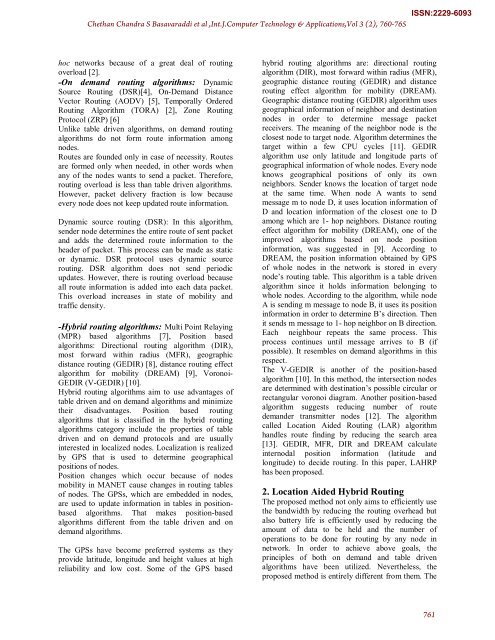A New Routing Algorithm in MANETS: Location Aided Hybrid Routing
A New Routing Algorithm in MANETS: Location Aided Hybrid Routing
A New Routing Algorithm in MANETS: Location Aided Hybrid Routing
Create successful ePaper yourself
Turn your PDF publications into a flip-book with our unique Google optimized e-Paper software.
Chethan Chandra S Basavaraddi et al ,Int.J.Computer Technology & Applications,Vol 3 (2), 760-765<br />
ISSN:2229-6093<br />
hoc networks because of a great deal of rout<strong>in</strong>g<br />
overload [2].<br />
-On demand rout<strong>in</strong>g algorithms: Dynamic<br />
Source <strong>Rout<strong>in</strong>g</strong> (DSR)[4], On-Demand Distance<br />
Vector <strong>Rout<strong>in</strong>g</strong> (AODV) [5], Temporally Ordered<br />
<strong>Rout<strong>in</strong>g</strong> <strong>Algorithm</strong> (TORA) [2], Zone <strong>Rout<strong>in</strong>g</strong><br />
Protocol (ZRP) [6]<br />
Unlike table driven algorithms, on demand rout<strong>in</strong>g<br />
algorithms do not form route <strong>in</strong>formation among<br />
nodes.<br />
Routes are founded only <strong>in</strong> case of necessity. Routes<br />
are formed only when needed, <strong>in</strong> other words when<br />
any of the nodes wants to send a packet. Therefore,<br />
rout<strong>in</strong>g overload is less than table driven algorithms.<br />
However, packet delivery fraction is low because<br />
every node does not keep updated route <strong>in</strong>formation.<br />
Dynamic source rout<strong>in</strong>g (DSR): In this algorithm,<br />
sender node determ<strong>in</strong>es the entire route of sent packet<br />
and adds the determ<strong>in</strong>ed route <strong>in</strong>formation to the<br />
header of packet. This process can be made as static<br />
or dynamic. DSR protocol uses dynamic source<br />
rout<strong>in</strong>g. DSR algorithm does not send periodic<br />
updates. However, there is rout<strong>in</strong>g overload because<br />
all route <strong>in</strong>formation is added <strong>in</strong>to each data packet.<br />
This overload <strong>in</strong>creases <strong>in</strong> state of mobility and<br />
traffic density.<br />
-<strong>Hybrid</strong> rout<strong>in</strong>g algorithms: Multi Po<strong>in</strong>t Relay<strong>in</strong>g<br />
(MPR) based algorithms [7], Position based<br />
algorithms: Directional rout<strong>in</strong>g algorithm (DIR),<br />
most forward with<strong>in</strong> radius (MFR), geographic<br />
distance rout<strong>in</strong>g (GEDIR) [8], distance rout<strong>in</strong>g effect<br />
algorithm for mobility (DREAM) [9], Voronoi-<br />
GEDIR (V-GEDIR) [10].<br />
<strong>Hybrid</strong> rout<strong>in</strong>g algorithms aim to use advantages of<br />
table driven and on demand algorithms and m<strong>in</strong>imize<br />
their disadvantages. Position based rout<strong>in</strong>g<br />
algorithms that is classified <strong>in</strong> the hybrid rout<strong>in</strong>g<br />
algorithms category <strong>in</strong>clude the properties of table<br />
driven and on demand protocols and are usually<br />
<strong>in</strong>terested <strong>in</strong> localized nodes. Localization is realized<br />
by GPS that is used to determ<strong>in</strong>e geographical<br />
positions of nodes.<br />
Position changes which occur because of nodes<br />
mobility <strong>in</strong> MANET cause changes <strong>in</strong> rout<strong>in</strong>g tables<br />
of nodes. The GPSs, which are embedded <strong>in</strong> nodes,<br />
are used to update <strong>in</strong>formation <strong>in</strong> tables <strong>in</strong> positionbased<br />
algorithms. That makes position-based<br />
algorithms different from the table driven and on<br />
demand algorithms.<br />
The GPSs have become preferred systems as they<br />
provide latitude, longitude and height values at high<br />
reliability and low cost. Some of the GPS based<br />
hybrid rout<strong>in</strong>g algorithms are: directional rout<strong>in</strong>g<br />
algorithm (DIR), most forward with<strong>in</strong> radius (MFR),<br />
geographic distance rout<strong>in</strong>g (GEDIR) and distance<br />
rout<strong>in</strong>g effect algorithm for mobility (DREAM).<br />
Geographic distance rout<strong>in</strong>g (GEDIR) algorithm uses<br />
geographical <strong>in</strong>formation of neighbor and dest<strong>in</strong>ation<br />
nodes <strong>in</strong> order to determ<strong>in</strong>e message packet<br />
receivers. The mean<strong>in</strong>g of the neighbor node is the<br />
closest node to target node. <strong>Algorithm</strong> determ<strong>in</strong>es the<br />
target with<strong>in</strong> a few CPU cycles [11]. GEDIR<br />
algorithm use only latitude and longitude parts of<br />
geographical <strong>in</strong>formation of whole nodes. Every node<br />
knows geographical positions of only its own<br />
neighbors. Sender knows the location of target node<br />
at the same time. When node A wants to send<br />
message m to node D, it uses location <strong>in</strong>formation of<br />
D and location <strong>in</strong>formation of the closest one to D<br />
among which are 1- hop neighbors. Distance rout<strong>in</strong>g<br />
effect algorithm for mobility (DREAM), one of the<br />
improved algorithms based on node position<br />
<strong>in</strong>formation, was suggested <strong>in</strong> [9]. Accord<strong>in</strong>g to<br />
DREAM, the position <strong>in</strong>formation obta<strong>in</strong>ed by GPS<br />
of whole nodes <strong>in</strong> the network is stored <strong>in</strong> every<br />
node’s rout<strong>in</strong>g table. This algorithm is a table driven<br />
algorithm s<strong>in</strong>ce it holds <strong>in</strong>formation belong<strong>in</strong>g to<br />
whole nodes. Accord<strong>in</strong>g to the algorithm, while node<br />
A is send<strong>in</strong>g m message to node B, it uses its position<br />
<strong>in</strong>formation <strong>in</strong> order to determ<strong>in</strong>e B’s direction. Then<br />
it sends m message to 1- hop neighbor on B direction.<br />
Each neighbour repeats the same process. This<br />
process cont<strong>in</strong>ues until message arrives to B (if<br />
possible). It resembles on demand algorithms <strong>in</strong> this<br />
respect.<br />
The V-GEDIR is another of the position-based<br />
algorithm [10]. In this method, the <strong>in</strong>tersection nodes<br />
are determ<strong>in</strong>ed with dest<strong>in</strong>ation’s possible circular or<br />
rectangular voronoi diagram. Another position-based<br />
algorithm suggests reduc<strong>in</strong>g number of route<br />
demander transmitter nodes [12]. The algorithm<br />
called <strong>Location</strong> <strong>Aided</strong> <strong>Rout<strong>in</strong>g</strong> (LAR) algorithm<br />
handles route f<strong>in</strong>d<strong>in</strong>g by reduc<strong>in</strong>g the search area<br />
[13]. GEDIR, MFR, DIR and DREAM calculate<br />
<strong>in</strong>ternodal position <strong>in</strong>formation (latitude and<br />
longitude) to decide rout<strong>in</strong>g. In this paper, LAHRP<br />
has been proposed.<br />
2. <strong>Location</strong> <strong>Aided</strong> <strong>Hybrid</strong> <strong>Rout<strong>in</strong>g</strong><br />
The proposed method not only aims to efficiently use<br />
the bandwidth by reduc<strong>in</strong>g the rout<strong>in</strong>g overhead but<br />
also battery life is efficiently used by reduc<strong>in</strong>g the<br />
amount of data to be held and the number of<br />
operations to be done for rout<strong>in</strong>g by any node <strong>in</strong><br />
network. In order to achieve above goals, the<br />
pr<strong>in</strong>ciples of both on demand and table driven<br />
algorithms have been utilized. Nevertheless, the<br />
proposed method is entirely different from them. The<br />
761
















